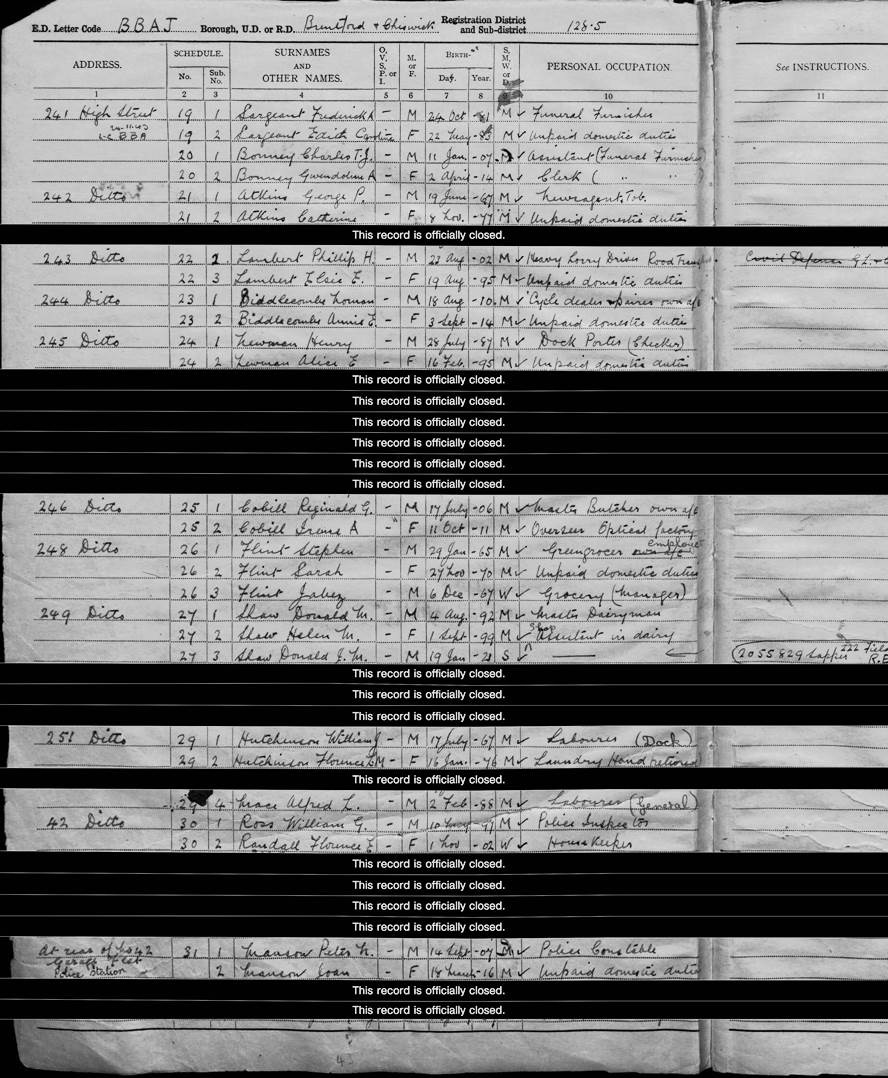Basics
Home and SearchSite Guide
Brentford Basics
Privacy Policy
Contact
People
FamiliesPhotos of people
Name indexes incl WW1
Memories
Lists, Documents, News
Occupations
Properties
Properties: High StreetProperties: non-High Street
Photos
Maps
1909/10 Valuation Index
Pub Hub
Can You Help?
Seeking...Mystery photos
Roads Off
A-Z listJanet's Research
HistoryBeach's Jam
Nowell Parr
Turner the Artist
Queen Victoria 1840
Brentford Market
80 High Street
Clitherow of Boston House
Four Croxford Brothers
Sources & More
They SaidBooks etc.
Web Links
Next
Site Technology
Author
Home and Search
Not Brentford
1939 Register 241-251 High Street
The 1939 Register, taken on 29 September 1939, provides a snapshot of the civilian population of England and Wales just after the outbreak of the Second World War. Individuals’ records remain closed or information in them redacted for 100 years from their date of birth (the 100 year rule) or until proof of death is verified.The records of the 1939 Register were subsequently used by the National Health Service at its inception in 1948 and became the NHS Central Register, transferred to the Health and Social Care Information Centre (HSCIC) in 2007. The records remained with the NHS up until 1991 – therefore some changes of names between 1939 and 1991 are listed in the records. All of these names appear in the indexes so, in these instances, you can search for an individual using either their former or subsequent name. (The above is taken from The National Archives website).
So what information does it provide for this stretch of Brentford High Street?
Eleven households are shown, covering numbers 241 to 251 and also the Police Station at no. 42 (some way to the east) and a garage flat. 27 people are shown and a further 17 whose details are redacted: these were born after 1915. If they have died then submitting a scan of their death certificate will open up the record for all to see.
Unlike the census no place of birth is given, but a bonus is having the exact date of birth; locating a missing person, even if they have a common name, may be possible.
As in a census occupations are given and here include a funeral furnisher, newsagent / tobacconist, heavy lorry driver, cycle dealer and repairer, dock porter, master butcher, overseer in an optical factory, greengrocer, grocer, master dairyman, dock labourer, retired laundry hand, police inspector, housekeeper and police constable. It is interesting to see master, as in master butcher and dairyman, still in use.
Wives are often recorded as doing 'unpaid domestic duties' - this was before they could contribute to the war effort - and there are also several assistants, clerks and the like. The final column, which has been cropped during the scanning process, appears to include information about wartime occupation: Donald Shaw junior being a sapper with the Royal Engineers, no. 2055829, Field 222... and Phillip Lambert Civil Defence G L & C.
From a personal perspective it is good to 'meet' people whose names are already familiar: for example the Newman family, who feature in a number of photos provided by Diane; also Donald Mackay Shaw; and William John Hutchinson at no. 251.
 |
Published January 2016